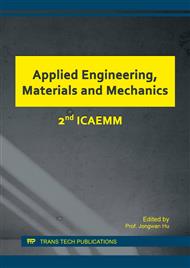[1]
M. G. Bekker, Introduction to Terrain Vehicle Systems, University of Michigan Press, Ann Arbor, (1969).
Google Scholar
[2]
R. M. Alexander and A. S. Jay, Estimates of Energy Cost for Quadrupedal Running Gaits, J. Zoology, 190(2) (1980) 155-192.
DOI: 10.1111/j.1469-7998.1980.tb07765.x
Google Scholar
[3]
V. B. Sukhanov, General System of Symmetrical Locomotion of Terrestrial Vertebrates and Some Features of Movement of Lower Tertapods, Acad. Sci. USSR, 10-11 (1968) 75.
Google Scholar
[4]
T. M. Giffin, R. Kram, S. J. Wickler, and D. F. Hoyt, Biomechanical and energetic determinants, of the walk-trot transition in horses, J. Exp. Biol. 207 (2004) 4215-4223.
DOI: 10.1242/jeb.01277
Google Scholar
[5]
E. F. Fisher and B. L. Fisher, A Survey of Legs of Insects and Spiders, IEEE J. Robot. Autom. 2 (1988) 984-986.
Google Scholar
[6]
F. Pfeiffer, H. J. Weidemann, and P. Danowski, Dynamics of the Walking Stick Insect, IEEE J. Robot. Autom. 3 (1990) 1458-1463.
Google Scholar
[7]
R. D. McGhee and G. I. Iswandhi, Adaptive Locomotion of a Multi-Legged Robot over Rough Terrain, IEEE Trans. Syst. Man. Cybernet. SMC-9(4) (1979) 176-182.
DOI: 10.1109/tsmc.1979.4310180
Google Scholar
[8]
S. M. Song, Dynamic Modeling, Stability Analysis and Energy Efficiency of a Quadrupedal Walking Machine, IEEE Int. Conf. Robot. Autom. (1979), pp.367-373.
Google Scholar
[9]
C. D. Zhang and S. M. Song, Stability Analysis of a Wave Crab Gaits of a Quadruped, J. Robot. Syst. 7(2) (1990) 243-276.
DOI: 10.1002/rob.4620070208
Google Scholar
[10]
M. S. Fisher, Walking, Climbing and Reaching: News on Kinematics and Dynamics and Questions about the Level of Control, 4'th Int'l Sym. on Adaptive Motion of Animals and Machines, CWRU, Cleveland, Ohio, June 1-6, (2008).
Google Scholar
[11]
T. M. Giffin, R. Kram, S. J. Wickler, and D. F. Hoyt, Biomechanical and energetic determinants, of the walk-trot transition in horses, J. Exp. Biol. 207 (2004) 4215-4223.
DOI: 10.1242/jeb.01277
Google Scholar
[12]
W. M. Silver, On the Equivalence of the Lagrangian and Newton-Euler Dynamics for the manipulators, Int. J. Robot. Res. 1(2) (1982) 60-70.
Google Scholar
[13]
D. E. Orin, R. B. McGhee, M. Vukobratovic and G. Hartoch, Kinematic and Kinetic Analysis of open-chain linkages utilizing Newton-Euler Methods, Math. Biosci. 43 (1979) 107-130.
DOI: 10.1016/0025-5564(79)90104-4
Google Scholar
[14]
J. Y. S, Luh, M. W. Walker and R. P. Paul, On-line computational scheme for mechanical manipulators, ASME J. Dyn. Syst. Measure. Contr. 120 (1980) 69-76.
Google Scholar
[15]
G. Gabrielli and, T. von Karman, What price speed specific power required for propulsion of vehicles, Mech. Eng. 72(10) (1950) 775-781.
Google Scholar


